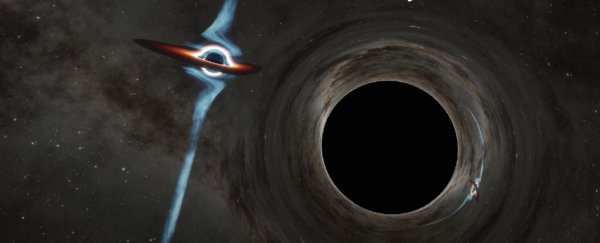A dance of death is taking place at the heart of a galaxy in the distant Universe.
Some 10 billion light-years away, two supermassive black holes are locked in an orbit so tight that they will collide with each other and form one much larger black hole in the relatively short time of just 10,000 years.
That equates to an orbital distance of just 0.03 light-years, around 50 times the average distance between the Sun and Pluto. Yet, so fast are they moving that it takes just two Earth years for the two objects to complete a binary orbit, compared to Pluto's 248 years.
There are multiple reasons why supermassive black hole binaries are of interest to astronomers.
Supermassive black holes are found at the centers of most galaxies, the nuclei around which everything else whirls. When two are found together, it indicates that two galaxies have come together.
We know this process occurs, so finding a supermassive black hole binary can tell us what it looks like in the final stages.
Supermassive black hole binaries can also tell us something about how these colossal objects – millions to billions of times the mass of the Sun – can get so incredibly massive.
Binary black hole mergers are one way this growth can occur. Finding binary supermassive black holes will help us understand if it's a common pathway for this growth, and that could lead to more accurate modeling.
The object in question is a quasar, named PKS 2131-021. These are galaxies in which the galactic nucleus is active; that is, the supermassive black hole is accreting matter at a furious rate, blazing with the heat generated by friction and gravity in the material roiling around the nucleus.
Some quasars blast jets of plasma almost at light-speed from the polar regions of the black hole, funneled along and accelerated by magnetic field lines around the object's exterior. PKS 2131 is a quasar blasting out a jet right in the direction of Earth, making it what we call a blazar.
A team of astronomers studying brightness variations in quasars noticed something odd about the PKS 2131 blazar beam in radio frequencies, finding the same signature in data collected back in 2008. It seemed to oscillate on regular timescales, its brightness fluctuating with an almost perfect sine wave pattern never before seen in a quasar.
"PKS 2131 was varying not just periodically, but sinusoidally," astronomer Tony Readhead of Caltech said. "That means that there is a pattern we can trace continuously over time."
The trail seemed to end when only two more peaks were found in archival data, one in 2005, and another in 1981. But then, in 2021, the project piqued the interest of astronomer Sandra O'Neill of Caltech. She and a team of researchers revisited data archives to see how far back in time they could trace this strange pattern.
They hit paydirt. In data from the Haystack Observatory made between 1975 and 1983, more of the pattern emerged, consistent with the timing of the rest of the observations.
"When we realized that the peaks and troughs of the light curve detected from recent times matched the peaks and troughs observed between 1975 and 1983, we knew something very special was going on," O'Neill said.
According to the team's analysis, the regular 'ticking' of the signal is generated by the orbital motion of the two black holes. As they go around each other on two-year timescales, the radio light dims and brightens, due to the orbital motion of the jet, which causes a Doppler shift that boosts the light when the black hole is moving towards us.
The archival data shows that this sine wave can be observed consistently for eight years from 1976, after which it disappeared for 20 years. This was probably due to a change or disruption in the supply of material feeding into the supermassive black hole. After 20 years, the pattern re-emerged, and has continued ever since, about 17 years now, the researchers said.
Another similar system, OJ 287, suggests that the interpretation is valid. This blazar has two close supermassive black holes orbiting each other every 12 years, at a separation of a third of a light-year. It shows fluctuations in radio brightness, too, albeit more irregularly and without the sinusoidal waveform.
Although we won't be around to see the eventual merger of the supermassive black holes in PKS 2131, they could show us how to look for similar systems. In turn, these could bring us closer to understanding how these colossal collisions take place.
The research has been published in The Astrophysical Journal Letters.
